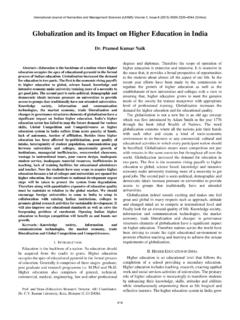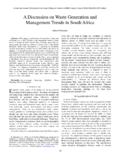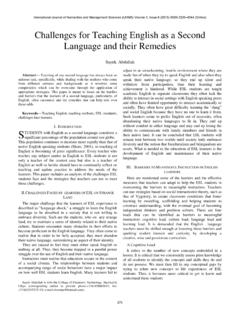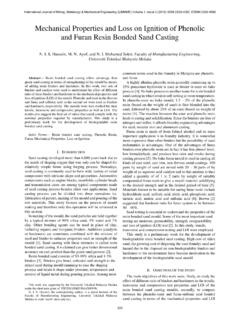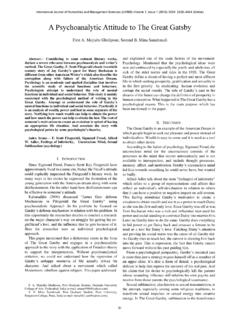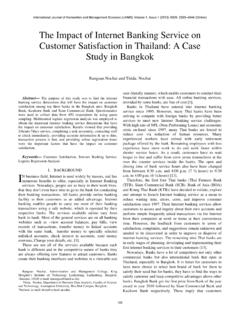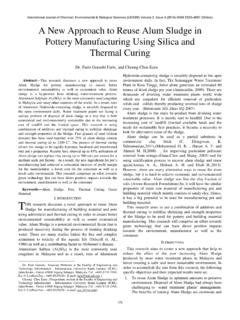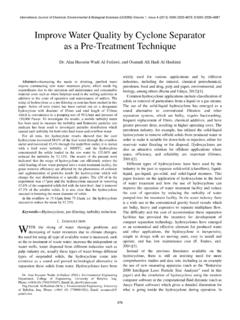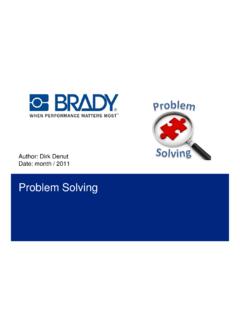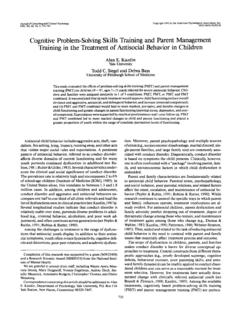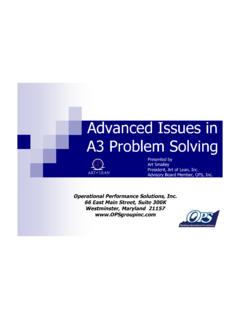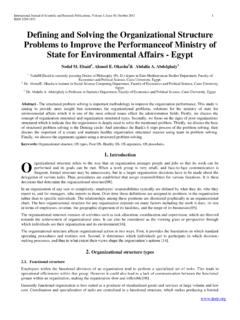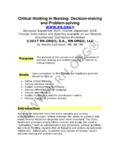Transcription of Comparison between Structured and Unstructured Grid ...
1 Comparison between Structured and Unstructured grid generation on Two Dimensional Flows Based on Finite Volume Method (FVM) Abobaker Mohammed Alakashi, and Dr. Ir. Bambang BasunoAbstract----Finite volume methods (FVM) had been recognized as one of numerical has proven highly successful in solving problem of fluid mechanics, meteorology, and many other engineering areas. The implementation of the finite volume required spatial discretization of domain of the problem in hand. In this respect one may adopt Structured or Unstructured grid approach. However their implementation will generate different algorithm although they are used the same Finite Volume scheme. The present work develop two computer codes both used a cell centered Finite volume scheme with different of term of spatial discretization. The first computer code used a Structured grid and the second one used Unstructured grid .
2 Both computer codes applied for solving two internal flow problems and one external flow problem of flow past through airfoil NACA 0012. Each of flow problems are solved for three different flow condition and their result presented in term of pressure and Mach number distribution along their geometry surfaces. Their Comparison result indicates the cell centered Finite volume scheme is a robust scheme, since their capability to produce same result are achievable without strongly influenced by manner how the mesh flow domain created. Keywords--- Structured grid , Unstructured grid , Euler solver, Cell-centred scheme I. INTRODUCTION HE mesh generation plays an important role in the numerical analysis procedure and over the past two decades, efficient methods of grid generation , together with the power of modern digital computers, have been the key to the development of numerical finite-volume (as well as finite-difference and finite-element) solutions of linear and non-linear partial differential equations in regions with boundaries of complex shape [1].
3 In the absence of viscous effects, the governing equation of fluid motion pass through an arbitrary body can be represented by Euler equation. This equation is in the form of a nonlinear differential system equation which their analytic solutions are difficult to be found. As a result a numerical approach is required. There are various forms to represent the governing equation of fluid motion. The governing equation of fluid motion in integral form allows one to apply a spatial discretization by use of finite volume approach. Abobaker Mohammed Alakashi is a PHD student of University Tun Hussein Onn Malaysia, 86400 Johor, Malaysia (e-mail: Dr. Ir. Bambang Basuno is a senior lecturer at Department of Aeronautic, University Tun Hussein Onn Malaysia, 86400 Johor, Malaysia (e-mail: In the relationship between the control volume and the grid cells, Finite Volume method can be classified into three groups.))
4 They are namely (1) Cell-centred scheme, (2) Cell-vertex scheme with overlapping control volumes and (3), Cell-vertex scheme with dual control volumes [2, 3]. In the Cell-centred Finite volume approach, the control volume is taken identically as its grid cell and the flow variables are described as the flow variables at the centroid of grid cells [4]. This approach give a better approach compared to the finite difference method which may require a fine grid for the same flow problem [4, 5]. Basically the Cell-centred Finite volume method provides a large number of options in defining the control volumes around which the conservation laws are expressed. Modifying the shape and location of the control volumes associated with a given mesh point, as well as varying the rules and accuracy for the evaluation of the fluxes through the control surfaces, gives considerable flexibility to the finite volume method [6,7].
5 In addition to this, discretizing to the integral form of the conservation laws directly ensure that the basic quantities mass, momentum and energy will remain conserved at the discrete level [8, 9]. Beside that the finite volume method allows the spatial discretisation is carried out directly in the physical space, transformations between coordinate systems are no needed any more [9, 10]. The Cell centered Finite volume scheme can be combined with Structured or Unstructured grid approach in discritizing of the flow domain of the problem in hand. However the two spatial discretizing approaches in their implementation as part of Cell centered finite volume method will generate two different algorithms in view of programming to computer code. As result two computer code need to be developed to handle in solving flow problem based a Cell centered Finite volume scheme in combining Structured and Unstructured grid generation .
6 The two developed computer applied to the case of two internal flow problems related to the internal flow problem past through a bump and the other one for the case of flow past through cascade. While in the case of external flow problem, these two computer code applied to the flow past through airfoil NACA 0012, Each case of flow problem as mentioned are treated with three different flow conditions. Their Comparison results in term of Mach number and pressure distribution along the body surface indicate in a good agreement. These results conclude the cell centered Finite volume scheme represent a robust scheme since this methods is not strongly dependent to the manner how discretizing flow domain are carried out. T International Journal of Mining, Metallurgy & Mechanical Engineering (IJMMME) Volume 2, Issue 2 (2014) ISSN 2320 4060 (Online)97 II.
7 METHODOLOGY A. Governing Equation Of Fluid Motion The governing equation of compressible inviscid two dimensional flows can be written in the integral form for a given region and boundary as Where: ; and In above equation, the independent variables are x,y and t, where x and y represent spatial independent and t is temporal independent. Other variables are defined as normally use in CFD analysis, namely the density , pressure p, component velocity in x-direction u, the component velocity in the y-direction v, the total energy E and the total enthalpy H [11]. For a perfect gas, there is a unique a relationship between E and H given as: and The discretization procedure follows the method of lines in decoupling the approximation of the spatial and temporal terms. The computational domain is divided into quadrilateral cells.
8 At each cell, the conservation laws is applied, such as to the cell ABCD as shown in figure (1). As result a system of ordinary differential equations are obtained and several alternative time stepping schemes can be adopted. Fig 1 Cells in the finite-volume approach Considering the grid cell ABCD of Figure (1), the side AB has a surface vector and a normal vector . They are defined as: The grid cell area of ABCD can be obtained from: ; Where Or in term of coordinate point (X, Y) as: The flux vector cross the side surface can be estimated by various approaches. The flux E crossing the side surface AB denoted as can be obtain by use of one following approaches. a. Average of fluxes Where: b. Flux of the average flow variable: c. Average of fluxes in A&B In the last approach, approach c, the flux EAcan be determined by firstly defining the flow variable Q at A as given below: (2) Then the average of the fluxes EA becomes: (3) In similar manner applies to the flux vectors H.
9 As result the implementation of the finite volume to the Eq. (1) makes that an ordinary differential equation with respect to time as given below[12,13]. Or (5) Through above equation, the flow problems are solved. However to solve above equation one has to make a mesh flow domain appropriately. This can be done by firstly choosing the grid topology. International Journal of Mining, Metallurgy & Mechanical Engineering (IJMMME) Volume 2, Issue 2 (2014) ISSN 2320 4060 (Online)98 B. grid generation Many kinds of the grid generation techniques can be used for defining the mesh of computational space. The grid generation based elliptic partial differential equation is the most popular one [14]. It allows the user to prescribe the angle between a grid line and boundary, controlling the grid spacing and their expansion ratio near surfaces.
10 Elliptic grid generation also guarantees a smooth grid in the entire flow domain. Thus, high quality, boundary orthogonal grids can be generated [15]. C. Elliptic grid generation This type of grid generation is motivated by the maximum principle for elliptic partial differential equations. Where the inverse grid transformation, (x, y), (x, y) can be obtained as the solution of (6) When and are monotone on the boundaries and following the maximum principle, it will make and will stay between these values. Furthermore, there will be no local extreme in the interior, and thus grid lines cannot fold. As result one may solve the Eq. 6 in other form as defined by the following equation. Above equation can be descritized by using a second order finite difference approach. The term , and becomes : The index i and j are and is a uniform subdivision of the coordinates, ini which: And The number of grid points is specified as To introduce more control over the grid , so called control functions are introduced into (6) [14, 17].
